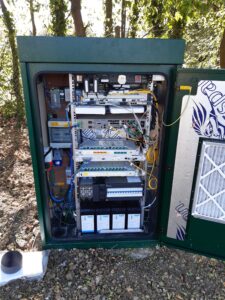 Fibre broadband
Fibre broadband
is a type of internet connection that offers a faster and more reliable internet connection than the alternatives. It’s one of the three widely available types of broadband technology available in the UK, the other two being ADSL and cable.
What other types of broadband are there?
The other types of broadband you can look for are:
- ADSL: ADSL is the most common type of connection, but also the slowest and cheapest of yo
- ur options. It works over the same line as your landline, using old copper wiring infrastructure
- Cable: Cable broadband isn’t as widely available as ADSL in the UK, but it usually offers faster download speeds. Rather than using old copper lines, they use a coaxial cable infrastructure belonging to another companies.
How does fibre broadband work?
Fibre broadband uses plastic or glass cables rather than the standard copper wires used in regular broadband connections.
Data is transmitted via beams of light, meaning it travels at light speed and won’t slow down over distances.
There are two main types of fibre broadband:
- FTTC, or fibre-to-the-cabinet: FTTC is the more common of the two, and as the name implies it uses fibre cables to the local cabinet in the street – and from there copper wires are used to connect it to your home. This type of connection offers ‘superfast’ download speeds
- FTTP, or fibre-to-the-premises: FTTP is also known as FTTH, or fibre-to-the-home, and it means the fibre cable goes directly to your home. As a result of cutting out the copper completely, it can offer faster ‘ultrafast’ or ‘gigabit’ speeds, but it’s therefore also more expensive
How fast is fibre broadband?
Fibre broadband is without doubt faster than the alternatives, cable or ADSL, and many providers offer superfast fibre broadband with downloads speeds of up to around 35Mbps or 60Mbps. Some superfast broadband deals offer speeds of up to 300Mbps.
If you have an ultrafast connection, your speeds may be advertised as 300-900Mbps
Do I need fibre broadband?
Fibre broadband can offer a very fast connection, and you’ll usually pay more for it than you would for cable or ADSL.
However, you should know whether it’ll be worth paying extra or not, based on how much you use the internet overall and how many people are in your household.
It might be helpful to broadly categorise internet users into three different types:
- Light users: Light internet users generally just use the web for everyday tasks like checking emails, banking or occasionally using social media
- Medium users: Medium internet users are on the web more often, regularly browsing social media or other websites and occasionally streaming video or audio
- Heavy users: Heavy internet users are the group most likely to benefit from fibre-optic broadband, as the high speeds ensure fewer interruptions when gaming, streaming and downloading video or audio or sharing files
Do I need unlimited broadband?
If you’re a heavy internet user, you might also benefit from an unlimited downloads broadband deal. Most providers offer this as standard but not all – so it’s worth keeping an eye out to make sure you don’t hit a download cap when you’ve still got things to do online.
What affects my broadband speed?
Aside from the type of connection you have, your download speeds are also likely to be affected by other people on your connection, devices in your home or the technology being used.
- People or devices using your connection: The more people using, or the more devices connected to your broadband, the more bandwidth is being used up – which means the overall connection speed will go down
- Electrical devices in your home: Electrical devices, even those not connected to the internet, may still cause interference with your broadband – so keep these as far away from your router as possible
- Quality of hardware: Old routers and cables, or those in bad condition, can also contribute to slower internet speeds – it might be worth asking your provider for an upgrade if it’s available
- Viruses and malware: Your computer might be slow in browsing the web if it’s got a virus or malware installed – try scanning your computer with anti-virus software
- Weather conditions: Stormy weather can affect phone lines, while underground cables can be damaged in freezing temperatures
- Time of day: During peak internet use hours, usually between 6 and 11pm, it’s normal to see slower broadband speeds
AZFO also offer a broadband speed checker tool, so you can see what kind of download speeds you’re getting and whether they match what your provider has promised.
Can I get fibre broadband?
Not all types of broadband are available in all areas of the UK – so when you compare broadband deals with AZFO you’ll be asked for your postcode. This way we’ll be able to show more accurate results for your area.
